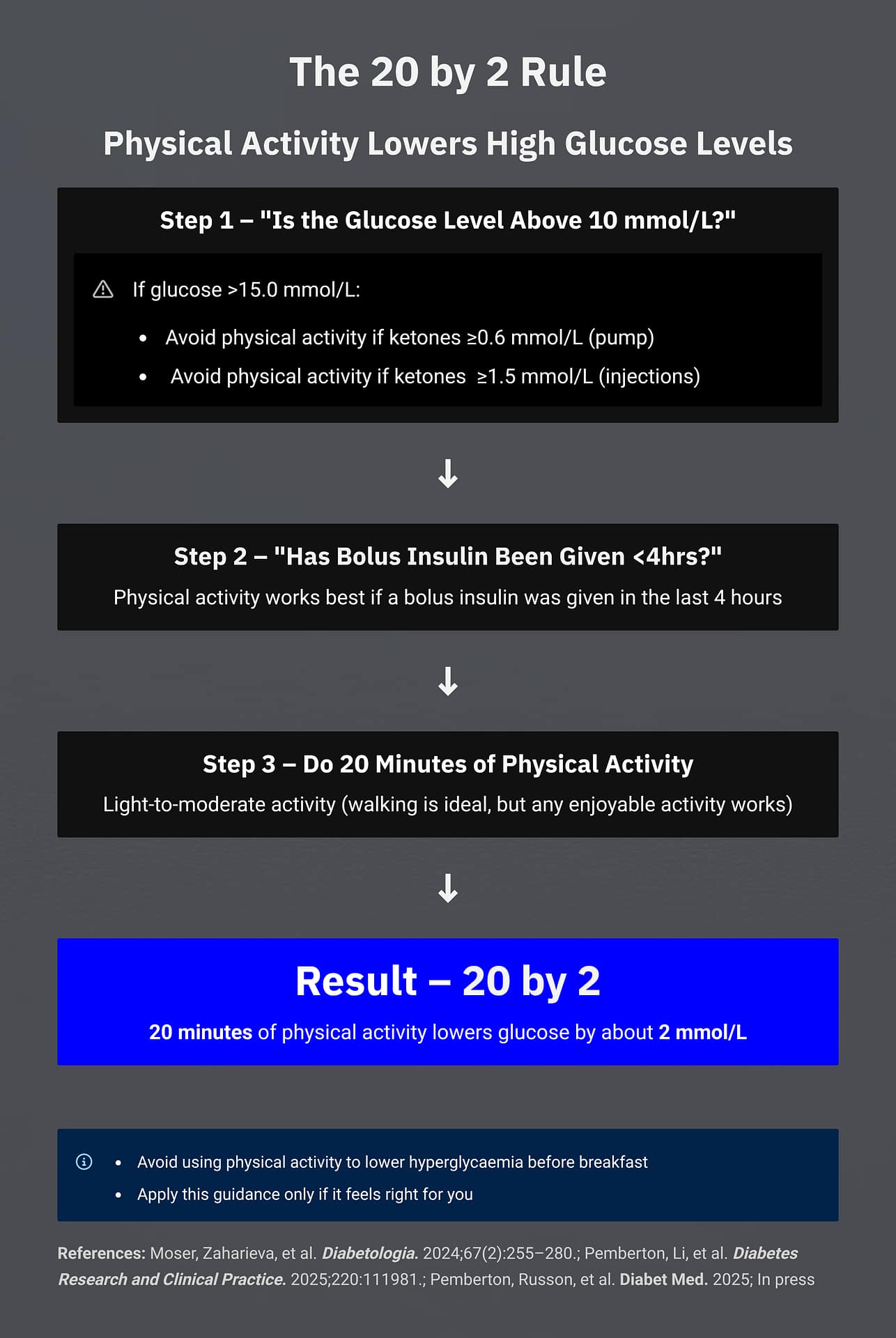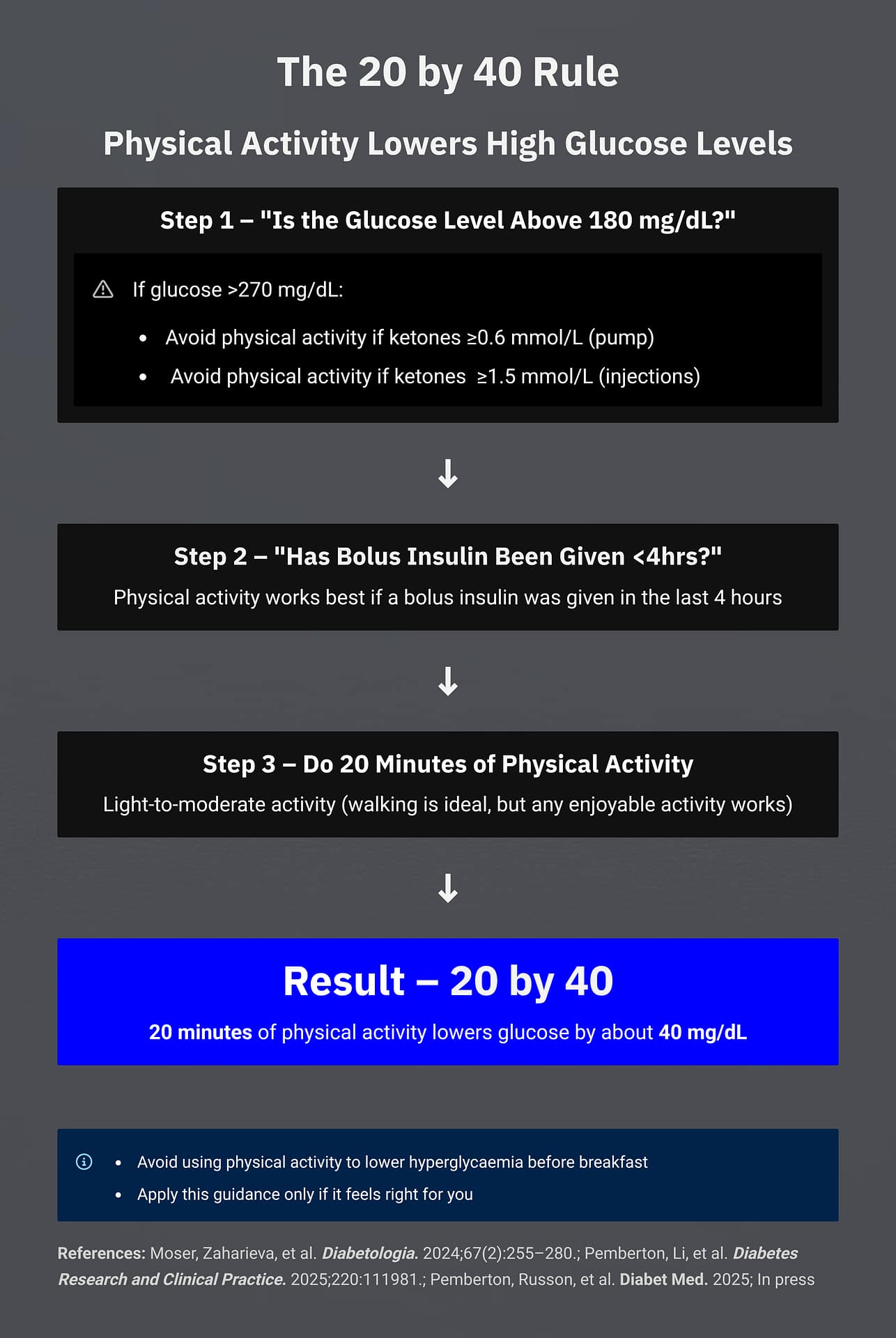Post-meal highs remain one of the toughest challenges in type 1 diabetes. Even with rapid insulin and the most advanced closed-loop systems, glucose often rises steeply before settling. The reason is simple: injected insulin is too slow to match fast-absorbing carbohydrate.
That is where physical activity changes the game. See below and download (if you want), my EASD 2025 Presenation for the background and evidence base.
EASD-2025-20-by-2Just 20 minutes of movement can supercharge the insulin you already have on board, lowering glucose faster and more predictably.
We call this the 20 by 2 rule
- 20 by 2 = 20 minutes of activity lowers glucose by around 2 mmol/L.

Alternatively, the 20 by 40 rule.
- 20 by 40 = the same effect expressed in US units — 40 mg/dL.

Two ways of saying the same thing, depending on where you are in the world.
Or as Grace would say, Daddy you got ’99 Problems, But High Ain’t One!’
Why it works
This is no longer just observation or anecdote. A matched-pair causal analysis, thanks to data scientist legend Dr Cat Russon, of more than 1,500 activity bouts has just been accepted for publication in Diabetic Medicine. For the first time, it moves us from observational data and small paediatric studies into robust causal inference evidence.
Crucially, the analysis showed consistency across:
- All activity types (walking, cycling, household tasks, sport)
- All therapy types (MDI, pump, hybrid closed loop)
- All ages and genders
This makes the message ubiquitous: anyone with type 1 diabetes can use activity to supercharge insulin and bring glucose back into range.
Supporting evidence:
- Matched-pair analysis (Pemberton & Russon et al, 2025, in press, Diabetic Medicine): 20 minutes of activity reduced glucose by 2.2 mmol/L on average (≈40 mg/dL), eight times more effective than matched rest.
- Pemeberton et al, 2025 Duration of physical activity required to Ameliorate hyperglycemia without causing hypoglycemia in type 1 diabetes: A T1DEXI adults and pediatric cohort analyses.
- Turner & Riddell, 2024: Pre-meal walks improved time-in-range compared with walking after meals.
- Campbell et al, 2023 — SIT LESS trial: Breaking up sitting with light activity reduced hyperglycaemia without extra hypos.
- Manohar et al, 2012: Even gentle walking halved post-meal spikes.
How to use 20 by 2 (20 by 40)
- When: If glucose is above 10 mmol/L and insulin has been given in the last 4 hours.
- What for 20 minutes: Walking, cycling, light circuits, even household chores all count.
- Safety: Avoid if glucose >15 mmol/L (≈270 mg/dL) with ketones present. Always check you have insulin on board.
How to use 20 by 40
- When: If glucose is above 180 mg/dL, and insulin has been given in the last 4 hours
- What for 20 minutes: Walking, cycling, light circuits, even household chores all count.
- Safety: Avoid if glucose >15 mmol/L (≈270 mg/dL) with ketones present. Always check you have insulin on board.
Support this work
This project is built independently. If you’d like to support and help me keep producing resources like this, consider:
Download and share (Educational Toolkit)
We’ve created take-home 20 by 2 / 20 by 40 guides in mmol/L and mg/dL — for clinics, teaching, and personal use.
- 20 by 2 – mmol/L version
- 20 by 40 – mg/dL version
- Download “99 Problems, But Highs Ain’t one”
- Download EASD 2025 Slides
These are free to use for education. Please share widely.
Further listening
Explore this theme on The Glucose Never Lies® Podcast:
Why it matters
Every 20-minute bout is a chance to bend the glucose curve back into range. More time in range means better energy, fewer complications, and a life where insulin and activity work together.
That’s the power of 20 by 2 — or 20 by 40.

